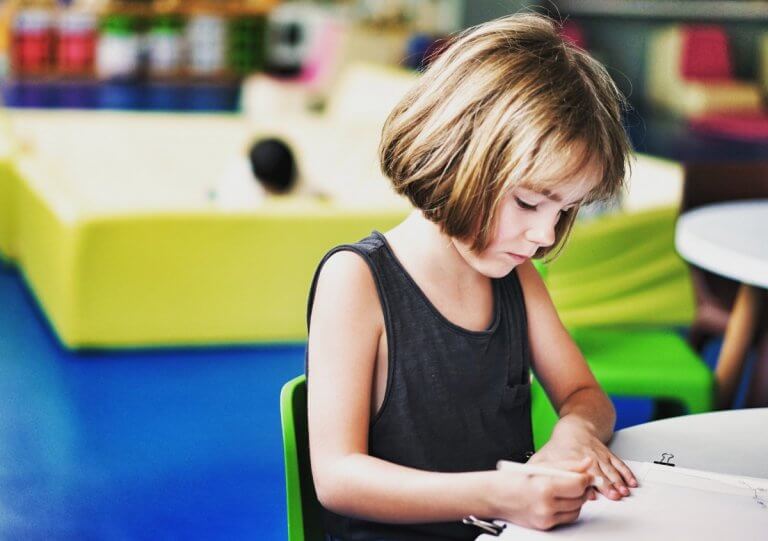
The education market is ultra-competitive. Parents are constantly on the lookout for schools that stand out in the sea of excellence – even at the pre-school level.
And it’s no surprise, seeing that childhood is a critical phase in human development. This includes the development of their motor and social skills, as well as their cognitive and language development. Naturally, parents want to get things right for their child from the start.
So what should parents keep an eye out for when ‘shopping’ for the right pre-school for their children?

White Lodge education psychologist Pinky Panda holding a student’s artwork for the school’s art exhibition under the theme “End Plastic Pollution”. Source: Yasmin Ahmad Kamil
Naturally, the experience of a school’s teachers, its curriculum and overall reliability are important factors to consider, says education psychologist Pinky Panda (yes, it’s her actual name!).
Panda, who works at White Lodge International Pre-school and Nursery Malaysia, says the school stands out from its competitors thanks to its 20-year history of success. Here, the curriculum is not arbitrarily imparted, but instead is tried and tested, she says.
White Lodge, which adopts learning objectives from a variety of educators, including High Scope, Reggio Emilia and Howard Gardner, is also a big promoter of inclusivity, with children with disabilities learning in the same class as their peers. However, these children have different milestones than their classmates.
“For example, a child who is mildly autistic or has sensory issues will be given a learning programme for their specific journey. His or her area would probably be socialising and picking up a language instead of being purely academic-based,” Panda explains.
In an effort to promote inclusivity, the school also celebrates the cultural diversity of students, hosting an annual ‘UN Day’ where parents are invited to participate and set up stalls relating to their country or culture at the school.
No child is a cookie cutter of another, which is why teachers at White Lodge work with children both on a group and individual basis. This is where teacher training stands out – they’re trained to identify and work on areas in which a child needs improvement, even within a group setting.
If a child is doing well in a particular area, they take that as their cue to challenge the child and ensure they don’t risk getting bored. Panda says pushing a child involves building their resilience and encouraging them not to give up before completing a task. Each teacher works out ways to engage each child.
“For example, bright children need to be engaged all the time or they’ll become bored in class,” she says. The teacher’s task includes facilitating learning rather than directing it to avoid a child falling back on their milestones or learning outcomes.
“For example, I will not ask you to pick up your phone like this, I would probably give you an opening: ‘Would you like to do this?’ The language used is indirect, so the challenge is indirect. However, you sometimes have to be direct to discipline them, so there’s a balance.”
Technology – yay or nay?

Young children are not encouraged to spend too much time on gadgets. Source: Shutterstock
While technology has become an inseparable part of our lives, White Lodge believes in minimising the use of gadgets for young children. Instead, teachers often engage their students in conversations, encouraging them to verbalise their thoughts and not be distracted by technology. While they do incorporate technology to facilitate student learning, this is primarily for older students.
Challenges for teachers include unconditioning students who are used to using gadgets, while parents are also advised to minimise exposing young children technology.
“It’s challenging if the parents themselves are on the phone and give their child an iPad when they’re at home,” she says. “Unfortunately, that’s what happens because we have very busy lives and most parents work.”
But as these children spend half of their day in school, this gives them a chance to break away from technology. In return, it can help them clear their concepts and pick up the language with their teachers who continually engage with students.
STEAM in the classroom

STEAM is peppered into the school’s curriculum – sudents were recently taught about plastic pollution through an art exhibition at the school. Source: Yasmin Ahmad Kamil
While STEAM (Science, Technology, Engineering, the Arts and Mathematics) has risen in prominence in recent years, elements of it has always been peppered into the White Lodge curriculum, notes Panda, adding that it grants students a holistic education.
For example, the school recently held an art exhibition under the theme “End Plastic Pollution”, getting students to discuss the topic, exposing them to images that showed how plastic does not disintegrate in dump yards, and even creating art from waste – i.e. plastic. Students use technology when researching information with their teacher, while mathematics is used when they engage in cooking activities, such as measuring proportions and understanding what happens to food when it’s cooked in an oven.
But moving forward, what lies in store for the future of pre-school education?
“It’s huge, it’s huge, and it’s only going to get bigger in Malaysia,” she opined. “As an expat [myself], it was not as big as this when I first came here but things are only going to improve because the need for the right kind of education is growing – all the young families want the best education for their children.”
She notes that there are many schools that have opened before eventually closing down, while there are also teachers who Google ways to teach students, without knowing the significance in these methods in the long run.
“But if you have tried and tested something, you can see the children grow. The early years are very important for a child,” says Panda, echoing the importance for parents to choose a school with a tried and tested curriculum.







